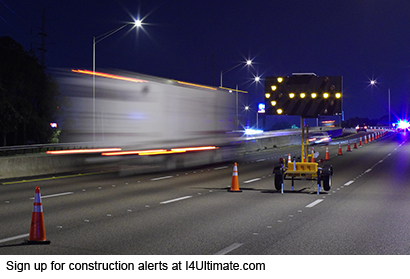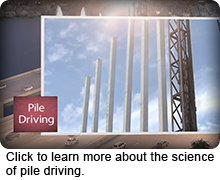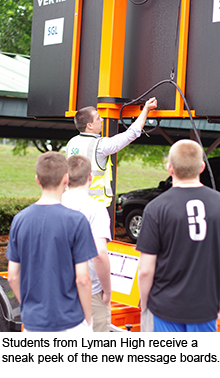|
|
|
|
CONSTRUCTION UPDATES:
I-4 Ultimate Project Ramps Up
|
 |
The I-4 Ultimate project is beginning to ramp up as there is evidence of construction activity throughout the 21-mile corridor.
Recent construction activities include drainage work in the College Park area near Midiron Drive and Minnesota Avenue. To accommodate the construction, the north end of Midiron Drive was closed. The road will remain closed at Minnesota Avenue during construction. In the near future, nearby Formosa Avenue is being rerouted away from Interstate 4 (I-4). A detour map was developed and shared with the impacted community.
Pile driving will be occurring during the construction of I-4 Ultimate. Learn more about the science of pile driving in the ongoing “What to Expect” video series.
Upcoming construction activity includes a ramp closure from eastbound I-4 to Princeton Street between 10 p.m. to 5 a.m. on Monday, June 1, 2015, to Thursday, June 4, 2015. The map outlines the detour of I-4 to the Par Street exit, turn right on Par Street, and turn right again on Clay Avenue to return to Princeton Street. To stay up to date on upcoming construction information, sign up for I-4 Ultimate advance construction alerts.
|
|
|
Construction Workers Rescue Pup
It was a case of a frightened, tiny puppy deciding to show itself at the right time to the right person.
Workers were checking a site near Kaley Avenue a few weeks ago when a scraggly, little animal popped out from behind a drainpipe and bared its teeth.
They thought it was a rat.
Then Mark Wiseman, who works for Volkert, a contractor on the I-4 Ultimate project, realized it was a pup. He scooped it up and decided someone should care for the little dog and it might as well be him. Wiseman got her to a vet, who declared that despite a few fleas, the Chihuahua-mix was in good health for a skinny, abandoned 4-week-old puppy.
Wiseman named the tiny survivor Kaley in honor of the spot where he found her. Local TV stations ran several reports about the puppy, and before long, she was famous enough to become the project’s unofficial mascot. She has found many new friends at the I-4 Ultimate office who are willing to look after her when Wiseman is out on a worksite.
Kaley is happy, frisky and gaining some weight. But maybe it’s no surprise she’s doing well under the watchful eye of her new owner. After all, that’s sort of Wiseman’s job. He’s a quality assurance supervisor.
|
|
|
The Science Behind Pile Driving
Every large structure built in the I-4 Ultimate project must have a solid foundation to support its massive bulk.
Instead of the familiar concrete-block foundation of a typical house, interstate structures rely on underground pillars made of concrete or steel – known as piles. Piles often must be sunk as deep as 120 feet into the ground to ensure safe, stable foundations for bridges and overpasses.
The only way to get those support pillars deep into the ground is by pile driving. Fortunately, there are techniques that can lessen the noise and vibration caused by that activity.
Wherever possible – especially in areas of soft or loose soils – pilings can be “vibrated” into the ground rather than driven using a hydraulic or diesel-powered hammer.
A special machine transmits vertical vibrations to a steel piling as it moves downward. While not an exact analogy, this method could be likened to shaking a butter knife while pressing it into packed sand.
Even when using the vibratory method, it may be necessary to use a pile-driver hammer to set the piles in place at the end of the process.
To ensure minimal impact, most pile driving will occur during the day. When it must be done at night, noise levels will be within local guidelines.
Members of the I-4 Ultimate team also will place seismographs between pile drivers and buildings. The instruments are set to alert workers about vibrations at a level that is far below any associated with structural damage. The seismographs send out cellular alerts to team members, if ground vibrations exceed those very low levels.
|
|
|
New Message Signs Bring New Capabilities
On the side of the road along Interstate 4 (I-4) are portable, electronically lit message boards.
During the Ultimate I-4 project, there may be as many as 35 of the large, wheel-mounted signs that inform drivers of ramp closings, changes in traffic patterns, upcoming construction work, lane shifts, detours, and other assorted messages to help keep motorists safe and informed.
A relatively new software application is allowing a handful of authorized members of the I-4 Ultimate project team to change the 12-by-7-foot message signs via smartphones.
If all 35 signs were in use and each needed to be changed at 35 separate locations throughout the 21-mile project, it could easily take one person several hours to drive to each sign and type in and test new messages using an attached keyboard.
To assign 35 people to go to their nearest sign and type in a new message could cause a major disruption in workflow. Moreover, it could put those workers at risk for injuries along the roadside. And if there were an immediate or emergency need to communicate to drivers, the remotely operated signs offer a fast solution.
“This new system solves all those problems,” said David Feise, the project’s Maintenance of Traffic Manager. “It means less labor and less time that a worker could be exposed to the traffic rushing by.”
The signs also include GPS software that sends an alert if the sign is moved without authorization.
|
|
|
|
|
|
Public participation is solicited without regard to race, color, national origin, age, sex, religion, disability or family status. Persons who require special accommodations under the Americans with Disabilities Act or persons who require translation services (free of charge) should contact Jennifer Smith, FDOT Title VI Coordinator by phone at (386) 943-5367, or via email at jennifer.smith2@dot.state.fl.us. If you are hearing or speech impaired, please contact us by using the Florida Relay Service, 1-800-955-8771 (TDD) or 1-800-955-8770 (Voice). |












